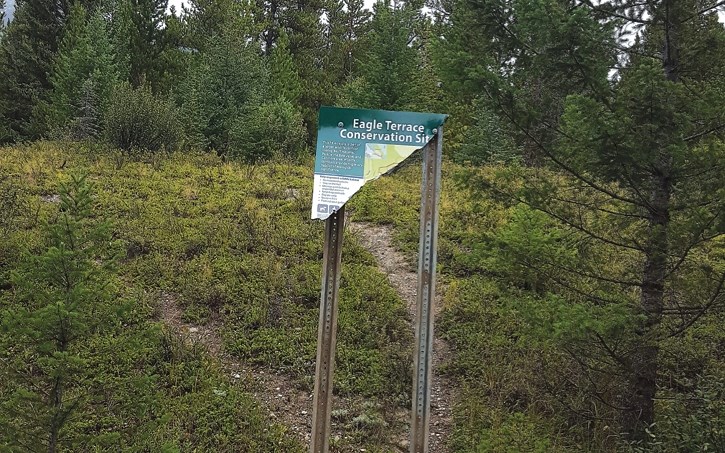CANMORE – Two parcels of land set aside for conservation sandwiched between the Eagle Terrace and Silvertip subdivisions is proving awkward for local officials in Canmore.
Originally, the 30 hectares were put into a conservation easement by developer Frank Kernick to be held by the Rocky Mountain Elk Foundation after the subdivision of Eagle Terrace was finished in the late 1990s.
But the Montana-based organization eventually pulled out of managing conservation lands in Canada, and handed over responsibility and title to three groups: the Nature Conservancy of Canada, Alberta Fish and Game Association and the Alberta Conservation Association (ACA).
With a mandate to protect and enhance fish and wildlife populations and their habitats for Albertans to enjoy, value and use, the ACA has since determined it does not have the resources to manage the Canmore lands according to CEO and president Todd Zimmerling.
“Essentially, the issue we have is our mandate is much more to conserve land, or habitat, and set it aside,” Zimmerling said. “Certainly we allow public use like hiking, hunting, or fishing, but we do not have the manpower to manage things such as trails.”
He said there have been circumstances in the past where members of the public have created their own recreational elements on the lands, like trails or even a makeshift luge track. Zimmerling said the ACA does not have the liability coverage for the kind of human activity, or risk to the public that currently exists. Even the risk of trees falling on nearby housing it outside the ACA’s mandate to manage, he said.
In 2016, the ACA and the Town of Canmore took efforts to reduce trail densities and decommission some of the linear features that have been created through human use in the area. They installed signage to inform the public about the change and why it was important for habitat conservation. Those signs, however, were subsequently vandalized and use of the myriad of trails continued.
Zimmerling said because the property is immediately adjacent to development and within a municipal boundary, it differs in the kind the management required and the ACA is not able to provide that.
As a result, the ACA approached Alberta Environment and Parks to take over management of one parcel adjacent to the Bow Valley Wildland Provincial Park and the Town of Canmore to take over the other side.
“We have heard from the province and it looks positive,” he said. “They will be able to take on a portion of the site and include it in the wildland park.”
General manager of municipal infrastructure Michael Fark briefed council in November about the offer from the ACA to manage 16.55 hectares and asked elected officials if the municpality would be interested in taking over.
If Canmore took over the conservation easement, it would be responsible for executing a management plan on the lands and that would come with $50,000 worth of work in 2019. That includes fencing, hazard tree removal, sign maintenance, annual monitoring, communication and other administrative costs.
Fark said the administration’s recommendation was to accept the land transfer and to incorporate its management into the broader planning process for wildlife corridors throughout the community.
The land is adjacent to the lower Silvertip ungulate wildlife corridor, which has been found to not be functioning as intended according to a third party review of an environmental impact statement prepared for the recent Northview apartment development on Palliser Trail.
Fark said the municipality is presently trying to address the issue of the corridor, and the adjacent lands offered by the ACA could be incorporated into that work. He added the issue of human use in wildlife corridors is one the Town of Canmore has already been trying to address throughout the community.
“This is all part of the problem we have to deal with,” Fark said. “The issue of human use in wildlife corridors is everywhere, so adding this parcel does not significantly change that responsibility, or that work.”
However, councillors were less than enthusiastic about the potential opportunity to manage the land into the future.
“There has been no end to grief with this,” said Mayor Borrowman with respect to managing human use within that specific area.
Borrowman described the land as a “dog’s breakfast” at a recent finance committee meeting and put forward a successful motion to remove the $50,000 in funding for a project to acquire the lands from the 2019 capital budget.
Fellow council members expressed disinterest in being responsible for lands that are difficult to manage because of the issue of human use.
“Yes we have to take responsibility for human use, but we don’t necessarily have to take responsibility for the lands that inappropriate human use is taking place on,” said Coun. Joanna McCallum.




